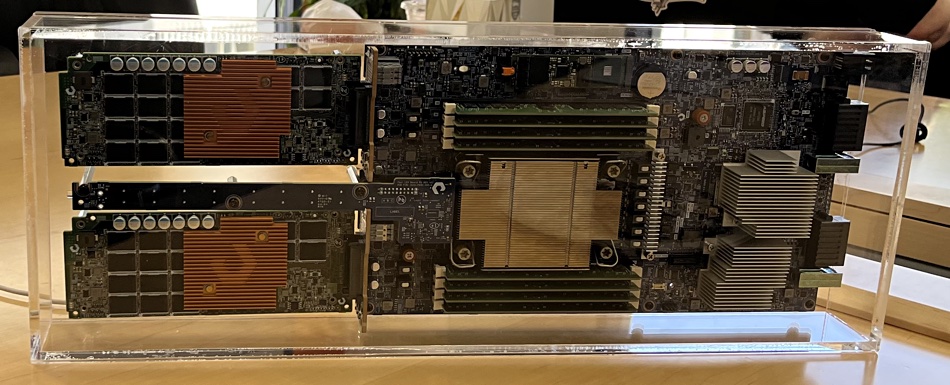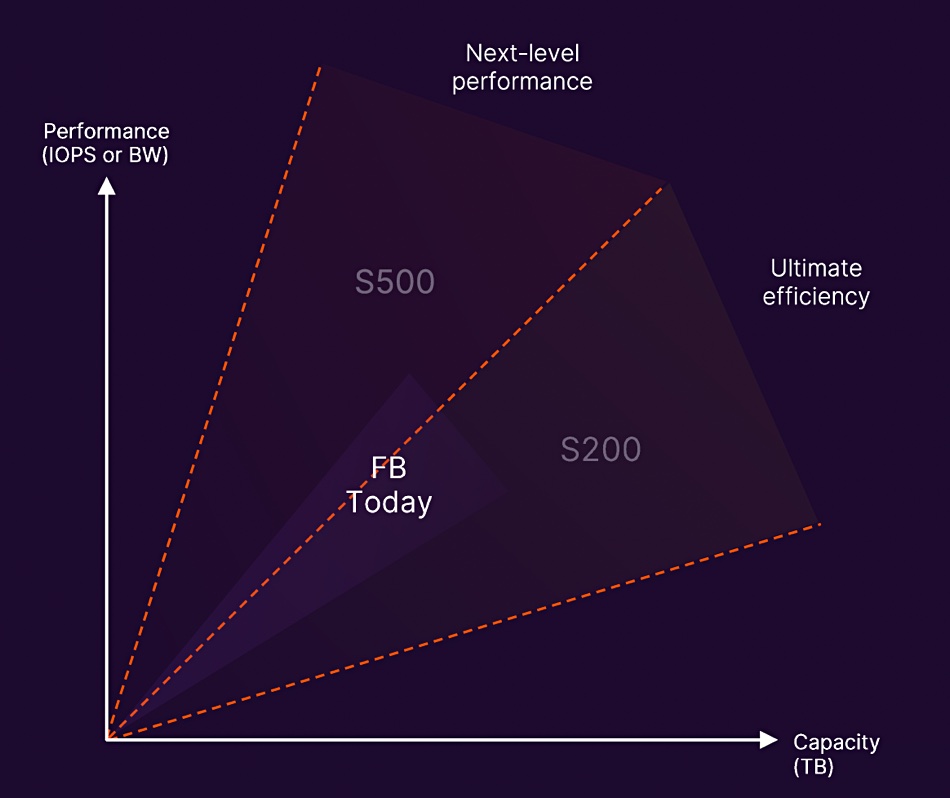Pure Storage has launched an updated FlashBlade unified file and object array, the //S, with Purity//FB v4.0 software and double the density, performance and power-efficiency of the current FlashBlade.
FlashBlade//S, with disaggregated and modular compute and storage design features, and Purity//FB 4.0 software enable storage, compute, and networking elements to be upgraded flexibly and non-disruptively.
Pure’s Matt Burr, GM for FlashBlade, said FlashBlade//S “is not only the last scale-out platform organizations will ever need but also the right choice for meeting environment and sustainability ambitions, which are increasingly important to customers.”
FlashBlade//S has 105 percent more usable TB per rack unit than FlashBlade, requires 48 percent less power and 28 percent less cooling.
Hardware
FlashBlade//S comes in a 25 percent larger chassis than FlashBlade – 5RU instead of 4 – and contains between 7 and 10 storage blades each populated with an IceLake SP-based controller board. One to four Direct Flash Modules (DFMs) – Pure’s in-house designed flash cards – plug into each storage blade, with a minimum of one per blade. Each DFM comes with 24 or 48TB of raw QLC (4bits/cell) capacity, the same flash as is used in the FlashArray//C. The current FlashBlade uses TLC (3bits/cell) NAND.

A storage blade has DDR4 memory DIMMs, PCIe 4 connections to the DFMs, and a 100GbitE data plane.

A FlashBlade//S chassis can hold up to 40 DFMs – a maximum of 1.92PB raw capacity, or 4PB at 2:1 compression. Put eight of these chassis in a rack and you have 16PB of raw capacity. Add in 2:1 data reduction and we’re looking at up to 32PB/rack. The Purity//FB OS supports this and more, and can handle billions of files and objects. Burr said FlashBlade//S is fast enough to enable object storage to be used for primary data storage as well as files.
The chassis has integrated 100GbitE networking and is 800GbitE-ready. It has a mid-plane, into which the storage blades plug, and that is 400GbitE-ready.

The current FlashBlade can have from 7 to 15x 8TB or 52TB blades in its chassis – a max of 780TB raw, and 1.6PB effective at 2:1 compression. It scales out to 10 chassis, linked by external fabric modules (XFMs), 150 blades in total. The system supports up to 15GB/sec bandwidth with 15 blades and a chassis has up to 16x 100GbitE ports.
A Pure spokesperson said: “Today, the largest FlashBlade system is 10-chassis, of 15 blades each (150 blades), with 52TB blades. With FlashBlade//S, we are targeting the same 10-chassis cluster size (now connected by upgraded external fabric modules, or XFMs). Remember though that each FlashBlade//S chassis is now far denser and more performant than the current FlashBlade chassis (roughly 2.5-3x as performant and dense), while requiring fewer compute blades (10 vs. 15). Additionally, with FlashBlade//S standardized on DirectFlash Modules (DFMs), the robust roadmap for DFMs will continue to add scale and capacity through density improvements.
“Net/Net, we expect the large 10-chassis clusters to reach roughly 2-3x the total capacity (~20-30PB depending on data reduction), and offer 2-3x the throughput, and grow from there.”
FlashBlade//S storage blade controllers are stateless, like VAST Data’s controllers (compute nodes). Unlike VAST Data’s hardware FlashBlade//S has no storage-class memory cache for metadata and incoming writes. “No SCM crutch” as a Pure briefing slide said, possibly in a poke at VAST Data.
A FlashBlade//S chassis scales up from 7x DFMs, one per blade, to 40 – four on each of the 10 blades. Then FlashBlade//S can scale out. If a blade fails or needs updating to the next generation its existing DFMs can be plugged into the new blade – a data-in-place upgrade effectively.
There are two FlashBlade//S models. The S200 is a capacity-optimized product, with DFM-loaded storage blades, while the S500 is a performance-optimised one, with lightly loaded storage blades. Both extend the performance and capacity envelope of the existing FlashBlade product;

FlashBlade//S use cases include AI and ML, high volume analytics, rapid restore for backups and ransomware recovery, manufacturing, high-performance simulation and EDA, medical and enterprise imaging, and genomics. Pure says its new FlashBlade has unmatched storage efficiency compared to any other scale-out storage system on the market.
The tide of required environmental, social, and governance (ESG) reporting is rising higher and higher. FlashBlade//S uses less power per terabyte – 1.3 watts/TB compared to the existing FlashBlade’s 2.3watts/TB. At PB scale that’s a lot of saved power. It means the new FlashBlade can be part of a good ESG report for customers, helping them show that they are working to reduce their datacentre power consumption.
Pure is building hardware commonality into its FlashBlade and FlashArray products with, for example, common power supplies and common DFMs. In the future we can envisage customers and Pure optimising fleets of FlashBlade and FlashArray systems by moving storage components, DFMs initially and compute (controller boards) eventually, between them to optimize performance and efficiency across the fleet. This wIll avoid stranded capacity and compute resources. System modelling based on fleet telemetry and AI will automate the production of fleet optimization configurations and specify which components ned to be moved where.
FlashBlade//S is available to order now.







